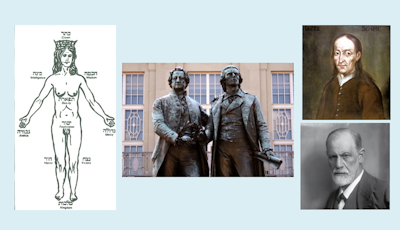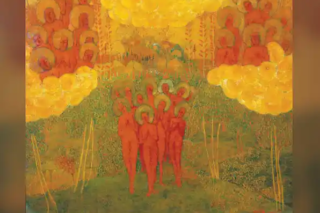In February 2019, the Bridging Voices: Contemporary Eastern Orthodox Identity and the Challenges of Pluralism and Sexual Diversity in a Secular Age project convened a virtual workshop. Participants offered short presentations to seed the conversation that would take place further during the August 2019 Oxford meeting.
My presentation was delivered extemporaneously. However, afterwards, the organizers asked for a written version that could be included in the interim report to the project funders. So I submitted this piece. It follows my notes for the talk. However, it also incorporates written materials from an earlier presentation that I gave in July 2018 in Helsinki, Finland, in case anyone wishes to read the longer source lecture from which some of this talk was derived.
For our first workshop the organizers asked me to speak to the concept of gender essentialism. Gender essentialism is the view that human beings fall into two groups that are ontologically and fixedly different from each other. This idea is commonly coupled with a dimorphic sexual binary and a presumption of heteronormativity, meaning that assigned biological sex (male/female), gender identity (man/woman), gender roles (masculine/feminine), and a heterosexual orientation are assumed to sort human beings into two complementary groups whose members pair off as husbands and wives and form families.
Orthodox mostly hold these views along with members or the larger society in which these ideas feed into nation building, marketing, and economies. But within the Orthodox sphere, these ideas are often seen as a part of the Holy Tradition. And we back them up with selective proof texts from the bible, from the patristic corpus, and from more recent arguments made by Orthodox theologians and bishops. These decorations give gender essentialism an air of ancient faith. We hear people say that it has been this way since the beginning. And as proof, we point to texts from the Genesis accounts of creation:
So God created humankind in his image, in the image of God he created them; male and female he created them. – Genesis 1:27
Therefore a man leaves his father and his mother and clings to his wife, and they become one flesh. – Genesis 2:24
When we read these passages through our contemporary lenses of gender essentialism and its particular version of complementarity, we end up with the basis for an argument for marriage and family between opposite-sex couples. From this kernel, we then build the nuclear family as “the little church” in the words of John Chrysostom. Then we further build godly societies based on these so-called “family values.”
Throughout the twentieth century, Orthodox theologians have made further arguments for gender essentialism and complementarity. The relationship between husband and wife is an image reflecting Christ and his Bride, the Church. Many theologians have gone as far as to read an analogy between the Son and the Spirit in the Holy Trinity, the two hands of the Father in the world, and man and woman, who come together to form the visible image of the invisible Father. While they are mostly careful to repeat the ancient patristic teachings that God transcends male and female, they continue to describe the work of the Son and the Holy Spirit in terms of masculine and feminine activities.
Gender essentialism, now dressed in the words of the Scriptures and the Fathers, is the basis for most all of our relationships. And any person who steps outside of the expected cultural norms becomes not only socially deviant, but a sinner. And unrepentant sinners are then further labeled as heretics and apostates.
There are, of course, a few exceptions. Orthodox still make exceptions for monastic vocations and make allowances for those who are not yet married among the laity. However, the pressure is strong for those who have not taken a vow of celibacy to pair off, form a family, and continue in the norm.
In the early Christian context, informed by the standards of philosophical and medical ideas of the day, human beings were not viewed in the fixed gender binary that is so common to us today. Rather, Hippocratic and Galenic medicine, as well as Aristotelian thought, conceived of human beings on a scale of greater to lesser perfection. Men were considered more perfect specimens of humanity—stronger, harder, warmer, less moist. Women were less perfect humans who had failed to live up to the high standards of manhood. They were weaker, softer. They had less heat and more moisture. In addition to these physical differences, men were believed to be more virtuous and morally superior to women. Men lived in the world of the intellect. Women lived at the level of the material and the sensate. Men could resist temptations and passions that women could not. However, the early Christian tradition held out hope for these weaker females. Through ascetic practice, they too could become manly.
Far from stable, masculinity and maleness were constantly performed in the ancient world and could be lost. Appearances could be deceiving. A man might be bearded and muscular, yet ancient physiognomists could discern in his speech, carriage, and demeanor the truth of his internal world. This was important because one enters into business dealings with true men, those who are trustworthy and disciplined.
Our own worldview reverses the ancient view. For the ancients bodies were the epiphenomena of deeper, inner realities. But for us, biological substrates form the basis of our concept of sex, then gender then flows from the body.
Gender essentialism in contemporary Orthodoxy has its roots in a variety of sources that were incorporated into nineteenth-century German Romanticism. These include the androgyne of Plato’s Symposium, ideas of preincarnate male and female paired souls in Lurianic Kabbalah, and the writings of the German mystic Jakob Böhme. This potent mixture fueled Romantic notions of love between male and female principles that inspired Russian Orthodox thinkers such as Soloviev and Bulgakov. It also influenced the German psychoanalytic tradition of Freud and Jung that were further read into the theological anthropologies of Nikolai Berdiaev and Pavel Evdokimov. While writers such as Soloviev and Bulgakov name and discuss at length the extra-Orthodox sources that inspired their thoughts on gender, more recent Orthodox thinkers who espouse these ideas (e.g., Thomas Hopko, Bradley Nassif) appear to be oblivious to their origins.
I am not suggesting that we reject gender essentialism solely on the basis of its origins in extra-Orthodox thought. Orthodoxy does not exist within a vacuum. From the very beginning, the Fathers were often well versed in the cultural and philosophical writings of their context. Sometimes the language and ideas imported from the broader culture closely resemble their uses in the larger society from which they are drawn. Sometimes the Fathers modified and redeployed vocabulary and concepts in new ways to express Christian sensibilities. This can also be said of Orthodoxy’s encounters with German Romanticism, as well as its interactions with other contemporary philosophical movements.
While I am not suggesting that we reject the gender essentialist paradigm that correlates men with the Son and women with the Holy Spirit because of its inspiration in German Romanticism, I still propose that we reject it. In all of its formulations, from Bulgakov to Hopko, Orthodox versions of gender essentialism relates all women to the one hypostasis of the Spirit, while relating all men back to the one hypostasis of the Son. In the process, the uniqueness and non-interchangeability of each human person is obscured. Instead of seeing unrepeatable persons, we see only men and women. And with this comes expected roles and assumed gifts for each based not on who she or he is created to be, but rather based on whether we happen to read each as a man or a woman. A one-size-fits-all, cookie-cutter approach that denies the diversity and wonder of God’s creation.
We often are unaware of the gender essentialist lens through which we view scripture, the patristic corpus, and the world more broadly. We assume it is part of the ancient tradition of the Church when it is anything but. As we continue our discussion of sexuality, it is essential that we cultivate our awareness of the historical contingency and recent development of our paradigm. Gender essentialism shapes not only our questions around on the etiology of homosexuality, but also our characterizations of same-sex desire, the idea that reparative therapy can produce a heterosexual orientation, our sacramental understandings of marriage, our definitions of family, our values in rearing children (including adoption practices), and our treatment of transgender and gender nonbinary persons within the Church. With so much at stake, the burden of proof rests on advocates of essentialism to evaluate carefully the fruits of the system, taking into account the well-being of LGBTQ+ persons whose lives are often disproportionately affected by the system’s demands.
Suggested Further Readings
Examples of Gender Essentialist Writings in Contemporary Orthodoxy
Hopko, Thomas. "On the Male Character of Christian Priesthood." St Vladimir's Theological Quarterly 19, no. 3 (1975): 147-73.
Nassif, Bradley. "The Holy Trinity and Same-Sex Marriage." In Public Orthodoxy, edited by Nathaniel Wood. New York: Fordham University, 2017. https://publicorthodoxy.org/2017/08/22/trinity-and-gay-marriage/
Constructions of Gender, Sexual Practices, and Sexual Identities in Antiquity and the Middle Ages
Gleason, Maud W. Making Men: Sophists and Self-Presentation in Ancient Rome. Princeton: Princeton University Press, 1995.
Halperin, David M. How to Do the History of Homosexuality. Chicago: University of Chicago Press, 2002.
Jordan, Mark. The Invention of Sodomy in Christian Theology. Chicago: University of Chicago Press, 1997.
Williams, Craig A. Roman Homosexuality. 2nd ed. Oxford: Oxford University Press, 2010.
Biblical Hermeneutics
Stone, Ken. “What the Homosexuality Debates Really Say about the Bible.” Chap. 2 in Out of the Shadows into the Light: Christianity and Homosexuality, edited by Miguel A. De La Torre, 19-38, 138-139. St. Louis: Chalice Press, 2009.
For Questions of Nature/Nurture and the Essentialist/Constructivist Debates
Sorano, Julia. Whipping Girl: A Transsexual Woman on Sexism and the Scapegoating of Femininity. 2nd ed. Berkeley: Seal Press, 2016.
Orthodox Constructive Theology on Sex, Gender, Sexuality, and Theological Anthropology
Rich, Bryce E. "Beyond Male and Female: Gender Essentialism and Orthodoxy." University of Chicago, 2017.




